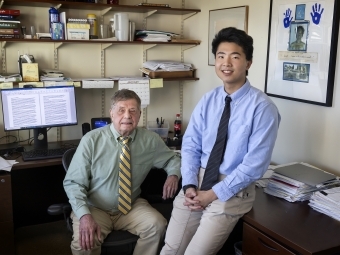Supply-Side Education: Prof, Students Expand Access to Econ Courses
June 1, 2022
- Author
- Mark Johnson

Davidson students are helping to fill a need in high schools that don’t have full-time economics teachers on staff. The students are pictured co-teaching an AP economics course at Christ the King Catholic High School.
The nations of Artland and Rayland each produce hats and bicycles. What if one country produces headwear and the other churns out two-wheeled vehicles, and, then, they start trading?
“You specialize in the product you’re best at,” Davidson College student River Meng ’23 said to the Advanced Placement macroeconomics class he was co-teaching at Christ the King Catholic High School, in Huntersville, North Carolina.
The class was hashing out an international trade exercise between the two fictional countries. Meng and fellow Davidson student Peter Clark were teaching how to determine measures such as opportunity cost and which country should specialize in which good.
Neither Meng, an economics major, nor Clark, a physics major who has taken several economics courses, plans to be a teacher. Their tutelage of the high school students represents Davidson’s outsized role in expanding Advanced Placement high school classes in economics, including a new textbook that Meng co-authored with Clark Ross, the Frontis W. Johnston Professor of Economics at the college.
Ross and his students have been teaching economics at Christ the King for three years. Enrollment has jumped from six, the first year, to 19 this spring. The class has evolved from students eagerly focused on economics to a broad sample of the student body.
Carl Semmler, principal at Christ the King, credits a steady increase in demand for financial literacy among high schoolers.
“More students than in the past,” he said, “are graduating from high school and majoring in business or finance.”
Supply is the problem. Small schools or schools in lower income school districts can’t afford to devote a full-time position to a teacher who specializes in economics. The schools must cover an array of broader topics.
That’s where Ross stepped in. He has boosted AP courses and tests for years, as an evaluator, a faculty evaluator and organizer of training for teachers that is held at Davidson. The textbook he and Meng authored is designed to be accessible, both in length, under 200 pages, and price, $40.
Schools seek to offer rigorous AP courses, in part, because they better prepare students for college and can help them skip required college courses. Christ the King had offered AP courses such as: calculus, biology, English and chemistry, but no economics.
Ross worked with school administrators and teachers to establish the AP economics course and for Davidson students to teach it with him. His involvement got them past the requirement that a student teacher already have a bachelor’s degree.
“I wanted to provide an opportunity for our students,” Ross said.

Economics Professor Clark Ross and River Meng ’23
Will Stifel, a 2020 Davidson alum, taught with Ross during the first year of the class and now is teaching AP micro- and macroeconomics at South Mecklenburg High School, in Charlotte.
“It gave me a lot of confidence,” Stifel said. “It gave me experience helping students through struggles they had. I really enjoyed that part of the teaching, and I use a lot of those skills now.”
Semmler saw a “quadruple win” in creating the class. The school now had AP economics teachers. Parents were excited to see the option for their kids. The school built a bridge with Davidson, where three Christ the King students have enrolled since the economics class started, and the Davidson students set examples for the high school class.
Meng and Clark, while not headed to teaching jobs, were intrigued by the opportunity to live out the leading and serving aspects of Davidson’s statement of purpose. They saw, for example, how it was harder to reach students who don’t volunteer much in class. Clark recalled one of those students coming up after class to ask questions.
“I remember being excited,” Clark said, “by how much he wanted to learn.”
Meng takes five minutes at the end of class to talk about what’s happening in the markets. One day the discussion dove into how inflation influences interest rates.
“I could see it in their faces,” he said, “’This is how what we’re learning in class applies in the real world.’”



